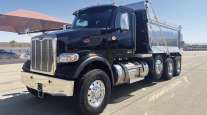OEMs Uncertain About Cuts In U.S. Spending on Defense
This story appears in the Nov. 28 print edition of Transport Topics.
Truck and component manufacturers who also build military products say they are confident they will be able to hold on to much of that business even as the U.S. armed forces face potential slashes in their future budgets.
Defense Department officials have made numerous statements in recent months that they expect budget cuts as the federal government seeks to reduce the overall budget deficit.
“As part of the debt ceiling agreement reached in August, the department must find more than $450 billion in savings over the next decade,” Defense Secretary Leon Panetta said in testimony Oct. 13 before the House Armed Services Committee, according to the agency’s website.
“We know that there are going to be cuts in the military budget, but we just don’t how many, or how deep,” John Daggett, spokesman for Oshkosh Corp., told Transport Topics. “It could be from $450 billion over the next 10 years, or up to $1 trillion.”
Daggett said that Oshkosh’s military sales, overwhelmingly to the United States’ armed forces, “typically” have made up 25% to 30% of Oshkosh’s annual revenue since 2000. The percentage spiked in some years when Oshkosh received rush orders, such as for the “mine-resistant, ambush-protected” vehicles known as MRAPs.
The Oshkosh spokesman said the company’s other revenue came from “access equipment” for construction, such as aerial work platforms, vertical mast lifts, stock pickers, scissor lifts and boom lifts; fire and emergency vehicles; and commercial trucks, mainly refuse haulers.
For its fiscal year ended Sept. 30, Oshkosh reported that defense revenue totaled $4.4 billion, down from $7.2 billion the year before; access equipment brought in $2 billion, down from $3 billion the previous year; fire and emergency brought in $800 million, down from $916 million, and commercial trucks raised $564.9 million, down from $622 million.
Oshkosh reported net income of $273.4 million for fiscal 2011, a sharp drop from $790 million the previous year.
Two other truck manufacturers, Navistar Inc., which builds International trucks, and Mack Trucks Inc., became involved with military sales in the first decade of this century, although both said they had long histories of military sales in previous wars.
Elissa Koc,a spokeswoman for Navistar Defense, said the sector received its first major contract in 2004, to supply trucks to the Afghan national police and army.
In 2005, Navistar received a contract to supply trucks to the Taiwanese military, she said.
In 2007, Navistar won its first major U.S. military contract, in partnership with other companies, to produce the armored vehicle Maxx-Pro MRAP, Koc said.
“Leveraging our commercial chassis lets us produce quickly and utilize manufacturing expertise,” Koc said, explaining how Navistar won that contract.
The MaxxPro is built on the chassis of the International WorkStar, the company’s main vocational truck.
“For the MaxxPro MRAP, we worked with other companies for our armoring and survivability solutions,” Koc said, noting that Navistar has supplied nearly 9,000 MaxxPros to date.
In a report Oct. 31 to Gabelli & Co.’s 35th Annual Automotive Aftermarket Symposium in Las Vegas, Navistar reported its defense sector expected fiscal 2011 revenue of $1.9 billion, down from $2 billion the previous year.
Navistar now has developed an armored vehicle on its own.
Meanwhile, Mack partnered in 2006 with VSE Corp. and Forschler & Associates to transform its Granite heavy-duty construction truck into a military linehaul truck, the Granite LHRT (linehaul replacement tractor). It no longer is in production.
Mack also supplied the chassis and powertrain for the Buffalo A1 MRAP, said Chuck Wissinger, Mack Defense marketing manager.
Mack declined to disclose its military revenue.
Tim Kraus, president of the Heavy Duty Manufacturers Association, the trade group for vehicle and component makers, said military cutbacks already have affected members.
“Many of the programs have been appropriated for, but the build rates are one-third of the original estimates,” Kraus told TT.
The decrease in Oshkosh’s fourth-quarter defense revenue primarily was due to lower production under the M-ATV (MRAP all-terrain vehicle) contract and lower M-ATV related parts and service sales, Oshkosh said Nov. 1.
“For our latest truck, the Sara-toga, we integrated and tested our own survivability solution,” Navistar’s Koc said, referring to the armor and other equipment to protect occupants.
Navistar showed off the Saratoga for the first time Oct. 10 at a military conference in Washington, D.C.
Koc said Navistar also produces the International MXT, which is sold to England’s military. “This is a lighter and more mobile MRAP-like vehicle,” she said.
Mack’s Wissinger, meanwhile, said the company “supplies a variety of vehicles to the U.S. military for use overseas, including tractors, wreckers and water/fuel tankers. We have also made sales directly to other foreign militaries for troop carriers, tractors and dump trucks.”
Dion Anglin, director of the defense market in North and South America for engine producer Cummins Inc., said the company’s products are “used in all types of equipment, including tactical trucks, power generation, material-handling equipment and combat vehicles.”
Anglin said Cummins didn’t transfer engines to military vehicles “since the requirements may be more rigorous than typical commercial vehicle applications.”
Cummins does not break out military sales separately in its earnings report.
Volvo Trucks, like Mack a subsidiary of Volvo AB, said it currently does not have military work. Paccar Inc., which owns Peterbilt and Kenworth trucks, also said it does no military work now.
Daimler Trucks North America, which builds Freightliner and Western Star trucks, declined comment on its military sales, as did Caterpillar Inc.




